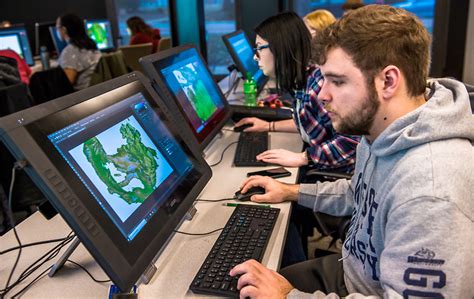Are you a passionate gamer with a creative flair? Do you dream of turning your love for video games into a successful career? If so, you’re in the right place. In this blog post, we’ll be delving into the exciting world of game art and design programs offered at universities across the United States. From exploring the field of game art and design to comparing different programs, we’ll cover it all. We’ll take a closer look at the curriculum structure, faculty expertise, internship opportunities, campus facilities, and student success stories. Whether you’re interested in animation, character design, or 3D modeling, we’ll help you navigate the options and find the perfect program for you. So, if you’re ready to take your first step from pixels to perfection, read on to discover the exciting opportunities awaiting you in the game art and design industry.
Table of Contents
Exploring the Game Art and Design Field
Game art and design is a dynamic and rapidly growing field that offers a wide range of career opportunities for creative individuals. From concept art and character design to level design and 3D modeling, the game art and design field encompasses a diverse array of disciplines and specializations.
Students who are interested in pursuing a career in game art and design can expect to explore a variety of exciting and innovative techniques, tools, and technologies that are used to create interactive and visually stunning gaming experiences.
Whether you’re interested in working for a major video game development studio, an independent game developer, or a mobile gaming company, a degree in game art and design can help you develop the skills and expertise needed to succeed in this competitive and fast-paced industry.
By delving into the game art and design field, aspiring artists and designers can gain valuable insights into the creative process, technical skills, and industry trends that are shaping the future of interactive entertainment.
Delving into Game Art and Design Programs
When it comes to game art and design programs, there are many options to choose from, each offering its own unique curriculum and opportunities for students. From traditional art schools to specialized game design institutes, the range of programs available can be overwhelming. It’s important for prospective students to thoroughly research and compare different programs to find the best fit for their interests and career goals.
One important factor to consider when delving into game art and design programs is the curriculum structure and course offerings. Look for programs that offer a balance of technical skill development and creative exploration, as well as courses that cover a range of topics, from character design and 3D modeling to game theory and interactive storytelling.
In addition to the curriculum, it’s essential to consider the expertise of the faculty and their industry connections. Experienced and well-connected instructors can provide valuable insights and networking opportunities for students as they prepare to enter the competitive game industry. Internship opportunities are another crucial aspect to look for in game art and design programs, as they provide real-world experience and the chance to build a professional portfolio.
Lastly, be sure to research the campus facilities and resources available for game art and design students, as well as any alumni achievements and industry partnerships that may enhance the program’s reputation. Job placement and career support services are also important to consider, as they can help students transition from education to employment.
Curriculum Structure and Course Offerings
When considering pursuing a career in game art and design, it is essential to understand the curriculum structure and course offerings of the programs you are interested in. A strong curriculum will provide you with the knowledge and skills necessary to succeed in the competitive field of game development.
Game art and design programs often offer a variety of courses that cover topics such as 3D modeling, animation, concept art, game development, and interactive media. These courses are designed to provide students with a well-rounded education that prepares them for the diverse demands of the industry.
Additionally, many programs also offer specialized courses that focus on specific aspects of game art and design, such as character design, level design, and virtual reality. This allows students to tailor their education to their individual interests and career goals.
Overall, a strong curriculum with a wide range of course offerings ensures that students are well-equipped to enter the industry with the skills and knowledge necessary to succeed.
Faculty Expertise and Industry Connections
Faculty Expertise and Industry Connections
When considering a career in game art and design, it is crucial to evaluate the faculty expertise and industry connections of the programs you are interested in. The faculty members play a key role in shaping the learning experience for students, as their expertise and experience directly impact the quality of education provided.
Faculty expertise in game art and design programs can encompass a wide range of skills and knowledge, including but not limited to, 3D modeling, animation, concept art, level design, and storytelling. It is important to research the background and specializations of the faculty members to ensure that they align with your own interests and career goals. Additionally, the industry experience of the faculty can provide valuable insights into current trends, technologies, and best practices within the field.
Furthermore, strong industry connections can significantly enhance the learning experience and future career prospects for students. Game art and design programs that have established relationships with industry professionals, studios, and organizations can offer unique opportunities for networking, mentorship, internships, and potential employment upon graduation.
Ultimately, the faculty expertise and industry connections of a program can make a significant difference in the quality of education and the potential for success in the competitive game art and design industry.
Internship Opportunities for Real-world Experience
Internship opportunities are a crucial aspect of gaining real-world experience in the game art and design field. Internships provide students with the chance to apply their skills in a professional setting, work alongside experienced professionals, and build a network within the industry. The hands-on experience gained through internships can be invaluable in preparing students for their future careers in game art and design.
Many universities and colleges offering game art and design programs have established partnerships with industry leaders to provide internship opportunities for their students. These partnerships often result in access to a wide range of internship options in both large and small game development companies, animation studios, and other related organizations. This gives students the opportunity to explore different facets of the industry and gain diverse experiences that can contribute to their professional growth.
Internship programs also offer students the chance to work on real-world projects and contribute to the development of actual games or interactive media. This hands-on experience can be highly beneficial in enhancing students’ portfolios and resumes, making them more competitive in the job market upon graduation. Additionally, internships allow students to observe and participate in the collaborative processes involved in game art and design, providing them with a deeper understanding of the industry’s dynamics and requirements.
Overall, internship opportunities are an essential part of the educational experience for aspiring game art and design professionals. They not only provide students with practical skills and industry connections but also offer a glimpse into their potential career paths, helping them make informed decisions about their future goals and aspirations.
Campus Facilities and Resources for Game Art
When it comes to pursuing a degree in game art and design, having access to top-notch campus facilities and resources can make all the difference in your education. At many institutions, students have the opportunity to work in state-of-the-art design studios equipped with the latest software and hardware for game development. Such facilities provide an immersive learning environment that mirrors the professional world of game design, allowing students to gain practical skills and experience right on campus.
Additionally, many game art programs offer access to resources such as 3D printers, motion capture studios, and sound design labs, giving students the tools they need to bring their creative visions to life. These resources not only enhance the learning experience but also prepare students for the real-world challenges they’ll face in the industry. With access to these cutting-edge facilities, aspiring game designers can bring their ideas to fruition and build a strong portfolio that will impress potential employers.
Furthermore, campus resources for game art often extend beyond physical facilities to include industry partnerships and collaborative projects. Many programs offer students the opportunity to work on real-world game development projects in collaboration with industry partners, giving them hands-on experience and valuable networking opportunities. These partnerships can lead to internships and job opportunities, providing students with a direct path to success in the field of game art and design.
In conclusion, the campus facilities and resources for game art play a crucial role in shaping the educational experience of aspiring game designers. With access to cutting-edge facilities, resources, and industry partnerships, students can develop the skills and experience needed to thrive in the competitive world of game design. By taking advantage of these opportunities, students can set themselves up for success and position themselves as leaders in the field of game art and design.
Student Success Stories and Alumni Achievements
Student success stories and alumni achievements are a testament to the quality of education and support offered in the game art and design programs. The program’s emphasis on practical skills and industry-relevant training has led to numerous success stories of students who have gone on to achieve great things in the gaming industry.
Many alumni have found success as game designers, 3D modelers, concept artists, and animators in top gaming companies. Their achievements serve as inspiration for current students, showing them the potential career paths and opportunities that await them after completing the program.
These success stories also reflect the strong industry connections and faculty expertise that provide students with the knowledge and skills needed to thrive in the competitive gaming industry. The program’s focus on hands-on learning and real-world projects has prepared students to excel in their careers and make significant contributions to the game art and design field.
From launching their own indie game studios to working on blockbuster titles, the achievements of alumni showcase the program’s ability to nurture and develop top talent in the game art and design field.
Industry Partnerships and Collaborative Projects
When it comes to pursuing a career in game art and design, industry partnerships and collaborative projects play a crucial role in providing students with real-world experience and networking opportunities. Many game art and design programs collaborate with industry professionals and companies to offer students hands-on projects, internships, and mentorship opportunities.
These partnerships provide students with the chance to work on actual game development projects, gain insights into the industry standards and practices, and build connections with potential employers. Collaborative projects with industry partners also allow students to showcase their skills and creativity, often leading to job opportunities and career advancements in the game art and design field.
Furthermore, these partnerships help game art and design programs stay updated with current industry trends, technologies, and demands, ensuring that students are equipped with the most relevant and practical skills for their future careers. Industry partnerships also provide a platform for students to receive feedback and guidance from industry professionals, allowing them to refine their work and develop a competitive edge in the job market.
Overall, industry partnerships and collaborative projects enhance the educational experience for students pursuing game art and design programs, preparing them for successful careers in the dynamic and competitive gaming industry.
Job Placement and Career Support Services
When it comes to pursuing a career in the game art and design field, it’s important to consider the job placement and career support services offered by different programs. Job placement rates and the support offered to students and alumni can make a significant difference in their success in the industry.
Some programs have dedicated career services departments that work closely with students to help them prepare for the job market. These services may include resume and portfolio development, interview preparation, networking opportunities, and job search assistance.
Additionally, programs with strong industry connections and partnerships may be able to offer students valuable internship opportunities that can lead to full-time employment after graduation. These connections can also provide students with mentoring and guidance from professionals in the field.
It’s also important to consider the track record of a program when it comes to job placement and the success of its alumni. Researching the career paths of former students and their achievements in the industry can provide insight into the quality of the program and the support it offers.
Comparing Game Art and Design Programs in the US
When it comes to pursuing a career in game art and design, one of the most important decisions you will make is choosing the right program. With so many options available across the United States, comparing these programs can be a daunting task. However, by carefully considering factors such as curriculum structure, faculty expertise, internship opportunities, and job placement support, you can make an informed decision that aligns with your career goals.
One of the key factors to consider when comparing game art and design programs is the curriculum structure. Look for a program that offers a well-rounded education, covering both technical skills and artistic principles. A strong emphasis on areas such as 3D modeling, animation, and interactive design will provide you with the necessary skills to succeed in the industry.
In addition to curriculum structure, it’s important to assess the faculty expertise and industry connections of each program. Experienced instructors with industry experience can provide valuable insights and mentorship. Furthermore, programs with strong connections to game development companies and other industry partners can offer valuable networking opportunities and real-world projects.
Another crucial aspect to consider is the availability of internship opportunities for real-world experience. The chance to apply your skills in a professional setting can be invaluable for building your portfolio and making connections in the industry. Look for programs that have established relationships with game studios and other relevant companies to maximize your internship opportunities.






